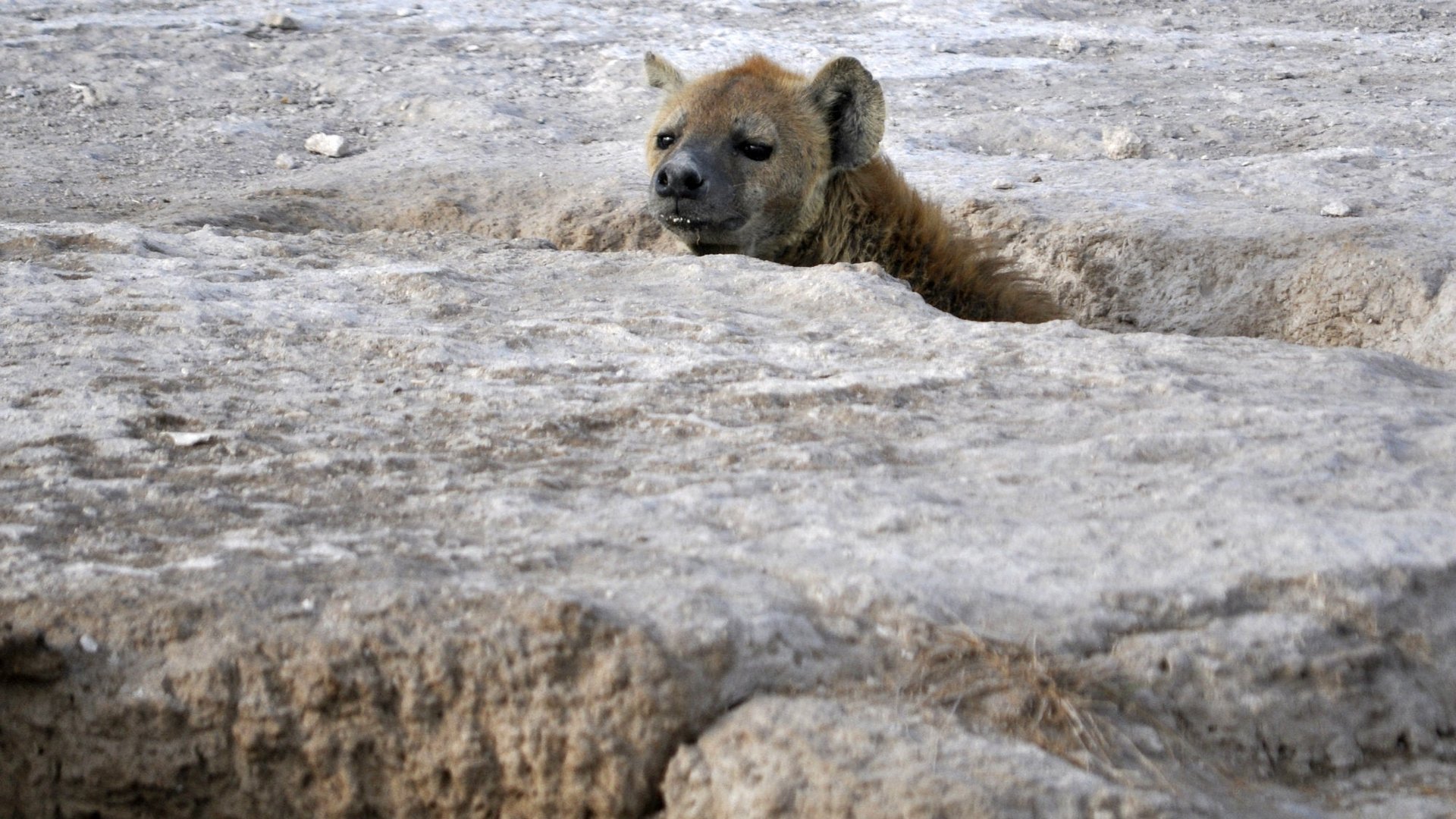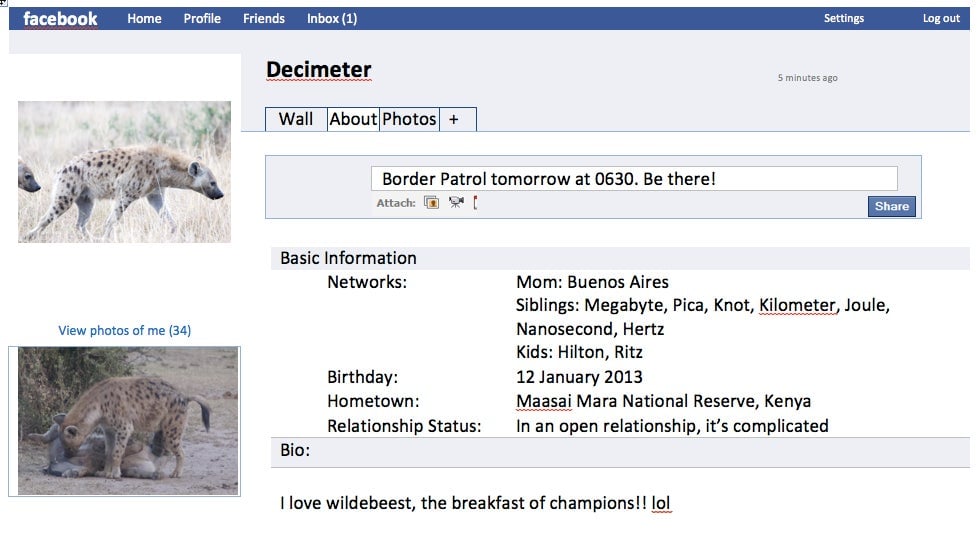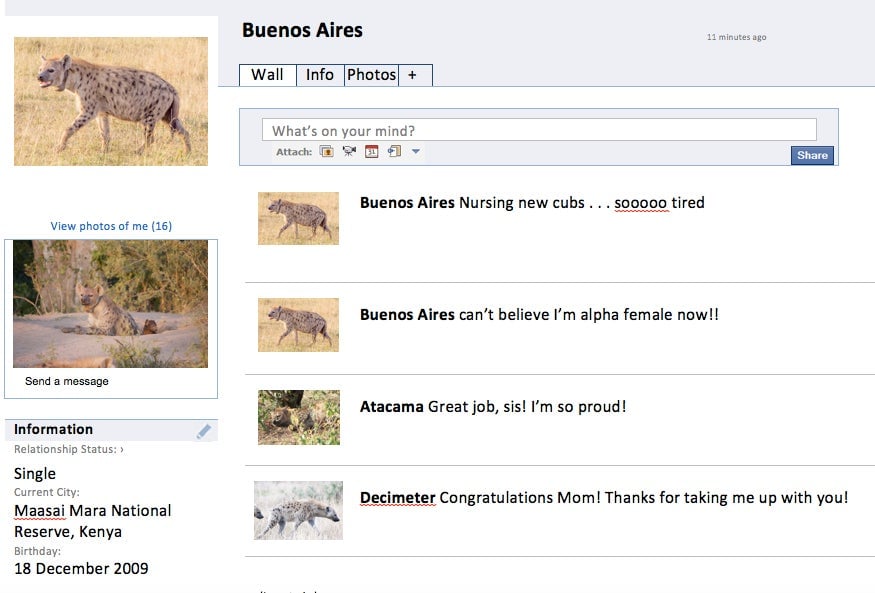Long before there was Facebook, there was Facebook for animals
If a spotted hyena in southern Kenya does anything—eats, mates, poops, dies—and a researcher from Michigan State University professor Kay Holekamp’s lab is around to see it, the detail goes into their field notes. The field notes eventually get entered in a database encompassing two decades of the hyenas’ observable universe. The database remembers things that probably long ago passed from the hyenas’ consciousness: what they ate, where they went, who they interacted with. The result is a catalog of hyena life nearly as exhaustive as those humans build for themselves on social media.


If a spotted hyena in southern Kenya does anything—eats, mates, poops, dies—and a researcher from Michigan State University professor Kay Holekamp’s lab is around to see it, the detail goes into their field notes. The field notes eventually get entered in a database encompassing two decades of the hyenas’ observable universe. The database remembers things that probably long ago passed from the hyenas’ consciousness: what they ate, where they went, who they interacted with. The result is a catalog of hyena life nearly as exhaustive as those humans build for themselves on social media.
“I can look up on the database right now who Murphy”—a hyena—“was hanging out with on a day in November 2009 and what she was doing,” says Kenna Lehmann, a doctoral candidate in biology.

A lot of animal studies are confined to the duration of a research grant or dissertation, a brief period of time that limits the scope of what can be studied. Big questions about how animal populations work—how their societies function, how they adapt to environmental stresses and shifts, why some clans or individuals falter while others thrive—can only be answered through long-term field studies. These are the projects in which (often many different) scientists return to a site year after year to tag and track the same group of animals.
The things we know about many mammal species are based upon thousands of observations of the minutiae of individual animals’ daily lives. All of those observations end up in a database of individuals’ photos, birth dates, social connections, and habits.
It’s tempting to anthropomorphize when looking through a document like the catalogue of west Iceland’s orcas and think, “It’s like Facebook for whales!” But in talking to scientists about the big data they’ve compiled on the animals they study, what’s striking is how much Facebook starts to feel like a place humans track themselves in the manner that biologists have been tracking mammals for dozens of years now.

“Marmots had Facebook before Facebook was Facebook,” says Dan Blumstein, a professor of ecology and evolutionary biology at the University of California-Los Angeles. Blumstein’s 55-year-old study on marmots in Colorado is one of the longest-running field studies of a mammal population.
A 34-page document posted (pdf) on the Blumstein’s lab’s website offers detailed instructions to researchers on which marmot activities are worth recording in their observation logs. The answer, in short, is all of them, from fights to foraging to social interactions, which are broken down into 33 distinct behaviors (sample: “sniff anogenital region (Sniff AG): initiator marmot sniffs butt-end of receiver marmot.”)
One of the criticisms of human social media is the apparent pointlessness of the data we choose to generate on ourselves: Who cares what you had for lunch? Why does anyone need to know who you’re hanging out with? For biologists, this ephemera is the stuff that makes the long days worthwhile. Every individual squirrel or monk seal feeding may not be interesting; no single day represents the sum of any mammal’s habits. But collectively, these data points form answers about how animals interact with their environments, and the adaptive strategies they employ —“It’s only through these long-term studies of plants and animals that you begin to understand how populations and species are evolving to environmental variance, and particularly systematic change,” Blumstein says.
The use of data in long-term animal population studies is interesting when considering the massive databases humans are busy compiling of our own daily activities, and how little we know about what that data is being used for, and by whom.
Humans study animals largely to understand how best to conserve them in the face of threats from other human activity. Data collected in long-term animal studies is for the most part used, ultimately, for the animals’ benefit. Similarly, the data humans hand over to companies like Google and Facebook have also been used for research on how we operate as a species. But the primary reason for the gathering of those data—the reason the companies offer their services free of charge—is to benefit the company that gathers the information. Facebook doesn’t want to see how we behave when left to our own instincts. It wants to give us an experience that will keep us coming back for more.
Unclouded by algorithms or filters, the data in a biologists’ field notes makes for a far more accurate picture of life than the ones we see on our social media feed—and a more interesting one, too.
“Soap operas are all around us,” Blumstein said. “You just have to be patient enough to see them.”